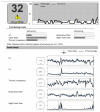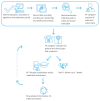Early Detection of Fluid Retention in Patients with Advanced Heart Failure: A Review of a Novel Multisensory Algorithm, HeartLogicTM
- PMID: 33671930
- PMCID: PMC7919012
- DOI: 10.3390/s21041361
Early Detection of Fluid Retention in Patients with Advanced Heart Failure: A Review of a Novel Multisensory Algorithm, HeartLogicTM
Abstract
Heart failure (HF) hospitalisations due to decompensation are associated with shorter life expectancy and lower quality of life. These hospitalisations pose a significant burden on the patients, doctors and healthcare resources. Early detection of an upcoming episode of decompensation may facilitate timely optimisation of the ambulatory medical treatment and thereby prevent heart-failure-related hospitalisations. The HeartLogicTM algorithm combines data from five sensors of cardiac implantable electronic devices into a cumulative index value. It has been developed for early detection of fluid retention in heart failure patients. This review aims to provide an overview of the current literature and experience with the HeartLogicTM algorithm, illustrate how the index can be implemented in daily clinical practice and discuss ongoing studies and potential future developments of interest.
Keywords: HeartLogicTM; admissions; cardiac implantable electronic devices; fluid retention; heart failure; multi sensor remote monitoring.
Conflict of interest statement
A.D.E. is a local sub-investigator for the PREEMPT-HF study. R.W.T. received a speaker’s honorarium from Boston Scientific in the past 5 years. The authors declare no conflict of interest.
Figures







Similar articles
-
Performance of a HeartLogicTM Based Care Path in the Management of a Real-World Chronic Heart Failure Population.Front Cardiovasc Med. 2022 May 6;9:883873. doi: 10.3389/fcvm.2022.883873. eCollection 2022. Front Cardiovasc Med. 2022. PMID: 35600477 Free PMC article.
-
Preliminary experience with the multisensor HeartLogic algorithm for heart failure monitoring: a retrospective case series report.ESC Heart Fail. 2019 Apr;6(2):308-318. doi: 10.1002/ehf2.12394. Epub 2019 Jan 11. ESC Heart Fail. 2019. PMID: 30632306 Free PMC article.
-
Fewer Worsening Heart Failure Events With HeartLogic on top of Standard Care: a Propensity-Matched Cohort Analysis.J Card Fail. 2023 Nov;29(11):1522-1530. doi: 10.1016/j.cardfail.2023.04.012. Epub 2023 May 21. J Card Fail. 2023. PMID: 37220824
-
Implantable cardiac resynchronization therapy devices to monitor heart failure clinical status.Curr Heart Fail Rep. 2007 Mar;4(1):48-52. doi: 10.1007/s11897-007-0026-1. Curr Heart Fail Rep. 2007. PMID: 17386186 Review.
-
Clinical Utility of HeartLogic, a Multiparametric Telemonitoring System, in Heart Failure.Card Fail Rev. 2022 Apr 21;8:e13. doi: 10.15420/cfr.2021.35. eCollection 2022 Jan. Card Fail Rev. 2022. PMID: 35516795 Free PMC article. Review.
Cited by
-
Triage-HF Validation in Heart Failure Clinical Practice: Importance of Episode Duration.Diagnostics (Basel). 2025 Jun 10;15(12):1476. doi: 10.3390/diagnostics15121476. Diagnostics (Basel). 2025. PMID: 40564797 Free PMC article.
-
Performance of a HeartLogicTM Based Care Path in the Management of a Real-World Chronic Heart Failure Population.Front Cardiovasc Med. 2022 May 6;9:883873. doi: 10.3389/fcvm.2022.883873. eCollection 2022. Front Cardiovasc Med. 2022. PMID: 35600477 Free PMC article.
-
Assessing the Accuracy of Artificial Intelligence Models in Scoliosis Classification and Suggested Therapeutic Approaches.J Clin Med. 2024 Jul 9;13(14):4013. doi: 10.3390/jcm13144013. J Clin Med. 2024. PMID: 39064053 Free PMC article.
-
Efficacy of the Cardiac Implantable Electronic Device Multisensory Triage-HF Algorithm in Heart Failure Care: A Real-World Clinical Experience.Sensors (Basel). 2024 Jun 5;24(11):3664. doi: 10.3390/s24113664. Sensors (Basel). 2024. PMID: 38894453 Free PMC article.
-
Enhancing Heart Failure Diagnosis Accuracy and Distinguishing It From Other Pulmonary Conditions: A Retrospective Case Series Study Leveraging the HeartLogic Parameters.Cureus. 2024 Aug 1;16(8):e65949. doi: 10.7759/cureus.65949. eCollection 2024 Aug. Cureus. 2024. PMID: 39221312 Free PMC article.
References
-
- Ponikowski P., Voors A.A., Anker S.D., Bueno H., Cleland J.G., Coats A.J., Falk V., Gonzalez-Juanatey J.R., Harjola V.P., Jankowska E.A., et al. 2016 ESC Guidelines for the diagnosis and treatment of acute and chronic heart failure: The Task Force for the diagnosis and treatment of acute and chronic heart failure of the European Society of Cardiology (ESC). Developed with the special contribution of the Heart Failure Association (HFA) of the ESC. Eur. J. Heart Fail. 2016;18:891–975. doi: 10.1002/ejhf.592. - DOI - PubMed
-
- Adams K.F., Jr., Fonarow G.C., Emerman C.L., LeJemtel T.H., Costanzo M.R., Abraham W.T., Berkowitz R.L., Galvao M., Horton D.P., Committee A.S.A., et al. Characteristics and outcomes of patients hospitalized for heart failure in the United States: Rationale, design, and preliminary observations from the first 100,000 cases in the Acute Decompensated Heart Failure National Registry (ADHERE) Am. Heart J. 2005;149:209–216. doi: 10.1016/j.ahj.2004.08.005. - DOI - PubMed
-
- Lewis E.F., Li Y., Pfeffer M.A., Solomon S.D., Weinfurt K.P., Velazquez E.J., Califf R.M., Rouleau J.L., Kober L., White H.D., et al. Impact of cardiovascular events on change in quality of life and utilities in patients after myocardial infarction: A VALIANT study (valsartan in acute myocardial infarction) JACC Heart Fail. 2014;2:159–165. doi: 10.1016/j.jchf.2013.12.003. - DOI - PubMed
-
- Cleland J.G., Abraham W.T., Linde C., Gold M.R., Young J.B., Claude Daubert J., Sherfesee L., Wells G.A., Tang A.S. An individual patient meta-analysis of five randomized trials assessing the effects of cardiac resynchronization therapy on morbidity and mortality in patients with symptomatic heart failure. Eur. Heart J. 2013;34:3547–3556. doi: 10.1093/eurheartj/eht290. - DOI - PMC - PubMed
Publication types
MeSH terms
LinkOut - more resources
Full Text Sources
Other Literature Sources
Medical
Research Materials
Miscellaneous

